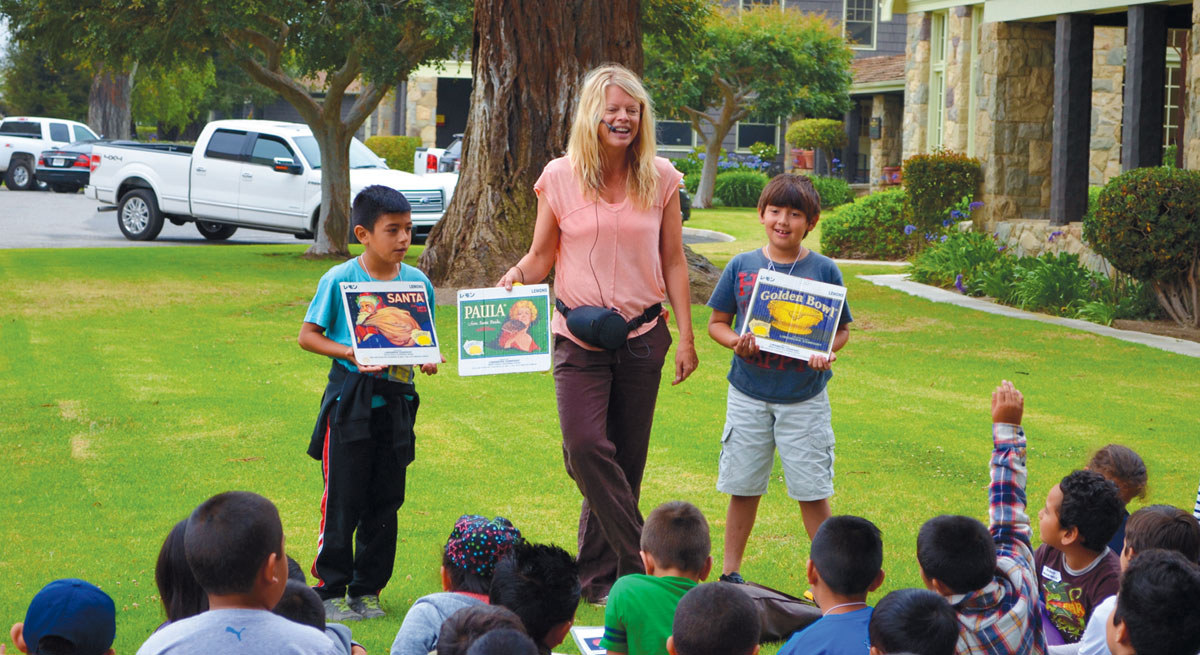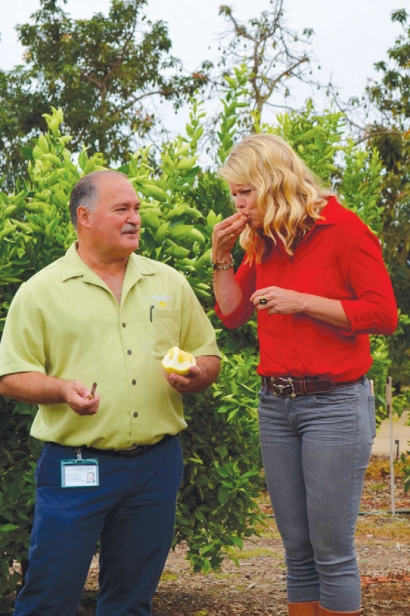Mary Maranville - Seeing Ag Through Children's Eyes
The idea was simple: Teach schoolchildren where the food they eat comes from. For Mary Maranville, her journey from the Adirondack Mountains to founder and director of the nonprofit Students for Eco-Education and Agriculture (SEEAG) in Ventura County was a little more complicated.
I sat down recently with Mary over a cup of coffee in Ojai, and she told me how, growing up on a dairy farm with a prolific two-acre biodynamic garden in Upstate New York, she was acutely aware of how the fresh milk, butter, cheese, meat, fruits and vegetables arrived on her family’s plates. She thought everyone knew where their food came from. (They didn’t.)
College years in Tarrytown immediately led to a sales and business career in the high-end bicycle industry, placing Maranville in Switzerland and traveling around Europe for work, then back to the United States.
After six months in Los Angeles, she moved to Ventura County. A new job and a few chance meetings in the field brought back images of her upbringing and set a light bulb ablaze in her mind to give schoolchildren a reality-based farm experience and share what she learned on that farm. One successful proposal later, and the seeds of SEEAG quickly took root.
What is the birth story of SEEAG?
All the agriculture that exists in Ventura County and meeting the local farmers really inspired me and made me nostalgic about my childhood. I just happened to get this job with the California Regional Environmental Education Community (CREEC), and one of my hats was meeting the environmental outdoor educators in the county, which included Channel Islands National Park, the Maritime Museum and Hansen Educational Center in Santa Paula. Hansen is beautiful and what they do is amazing. It was there, where I saw one of their field trips, I thought, “I can do this, and I can do it in a way that complements what they are doing.” But I really wanted to bring kids to a real, working, agricultural ranch, a place that grows food, ships food.
When did you know you were on the right path?
(Smiles widely.) That first year, in 2008–09, I was going to the all the classrooms, running all the field trips, and raising all the money. Every time I did a classroom presentation, I had all these little eyes looking at me, this energy coming from these pure, positive, very inquisitive little brains and minds. That’s when I knew I was on the right path, and I believe every presentation to follow inflated with bliss. I seriously felt blissful. I thought, “Wow! I landed in the right spot.”
Who were some farmers who helped mentor you and the SEEAG program?
I’ve had many mentors. One is Johnny Fonteyn from Rio Gozo Farm in Ojai. Steve Gill [of Gills Onions in Oxnard], absolutely. Tomas Gonzalez, Limoneira’s manager of food safety & sustainability, and Camille Yanez [Limoneira’s marketing coordinator]. And another person is Casey Houweling [of Houweling’s Tomatoes in Camarillo], whose hydroponic tomato systems are mind bending.
What was one of your first goals with SEEAG?
I wanted to teach 500 kids a school year about where their food comes from. At the time, 500 seemed like a lot, but we saw 492 kids that first year. After that, 500 quickly became 1,000, and word spread. The quality of the program spread, plus the fact it was free, so I had teachers contacting me left and right to sign up because they believed in it. Soon, 1,000 kids became 2,000 became 3,000, and this past school year we saw over 4,000 kids. (Laughs.)
Do you ever see teachers furthering the SEEAG curriculum into their lesson plans?
Well, we teach kids that plants are at the beginning of the food chain, and about the plant sciences, earth science and that a farm is its own ecosystem. Your backyard is an ecosystem—you have soil, plants, animals, the natural resources, the water, lack of water. All those things are what teachers take back to their classrooms. Especially now, the teachers are really focusing on water conservation. And the kids then teach their parents: “Turn off that water fountain” or “Don’t wash that car in the driveway.”
Do you think SEEAG is helping to inspire a younger generation to be excited and proud about taking over the family farm once their parents or grandparents retire?
Yes, we do believe we are building a new generation of agricultural and food ambassadors. We partner with Young Farmers and Ranchers, whose whole mission is to foster this young generation whose grandfathers or parents were involved in ag or farming. With SEEAG, we teach mostly third graders; I hope one day a 22-year-old will walk up to me and say, “I remember when you gave me that field trip. I ended up going to Cal Poly and earned an ag degree, and now I work at a farm.” That would be the ultimate.
Beyond the kids, do you get inspiration from anywhere else?
It’s the kids, definitely. Also, for me, it’s thinking about my dad and how much he loved farming. A lot of kids at my school had fathers who were doctors, lawyers, accountants, but my dad was a farmer. I really didn’t appreciate it, and I wish someone had come to my school and told me that my dad was out there helping people, helping to put food on people’s tables. I wanted to share this with schoolchildren who love food but who are disconnected from it.
Do you consider yourself a leader in the field of ag education?
Yes, I do now. Had you asked me that question a few years ago, I would have said, “No.” Maybe one of the reasons I do now is because of Farm Day [this year on Sept. 26]. I’m not originally from this county, and when I learned how wonderful all the farmers here are and how hard they work to put food on people’s tables, I really wanted to become an advocate for them.
Do you see the SEEAG program growing into a statewide or national program?
We do want to become statewide and, eventually, national, maybe even global. Not necessarily with boots on the ground, but we are hoping to share a “The Journey of Our Food” curriculum, and there is a plan beginning to take shape to help us institute it.
It seems Farm Day is really an extension of the SEEAG program. Is that fair?
That is very fair. Exactly. For me, now, I’ve had this paradigm shift that constantly makes me wonder where everything I’m eating comes from. And while we are now teaching kids, many adults don’t know where their food comes from. Farm Day is an extension of what we are already doing with kids, but it’s now for all generations.
Is this something you see going national?
Yes. There is a Flag Day and an Earth Day, why can’t we have a National Farm Day?
What is your five-year plan?
Well, there is the SEEAG five-year plan and then the Mary five-year plan. The plan for SEEAG is to be in Santa Barbara, L.A. and Ventura counties, reaching more kids. For example, we’re seeing 4,000 kids here and in Los Angeles County, and there are 10,000 third graders. And we also want more people to take the Farm Day tours.
For Mary, I feel like I just went through a six-year-long labor. I have been living and breathing and sleeping SEEAG, even dreaming about SEEAG. I don’t know if I can keep up with that dedication, but I hope that I can. The five-year plan for me is to keep running Farm Day and SEEAG. One of my personal goals is to buy back the land where my grandfather founded a Holstein dairy and raised Standardbred harness race horses in upstate New York. The house is gone now, the farm is gone, but the land is still gorgeous and the Irish rock walls are still there.
I want to have a working farm/ranch here with two miniature alpacas, two Jersey cows, two sheep, chickens and have a farm house back east. That’s Mary’s goal.
SEEAG IN A NUTSHELL
As a nonprofit organization, Students for Eco-Education and Agriculture (SEEAG) focuses on providing ag education to third-grade students throughout Ventura County. Maranville or one of her team gives a 45-minute in-classroom introduction on ag literacy, information on locally grown crops and where their food comes from.
At a later date, the class takes a field trip to Limoneira Ranch in Santa Paula, where they go on a two-and-a-half-hour tour that takes the kids on a journey of a lemon from field to table. Starting in the orchards, they witness lemons growing on trees, learn about harvesting and observe the workings inside the historic packinghouse. Then they go back to the orchard to pick a lemon to bring home. The field trip is free to schools.
Ryan A. Smith is an Ojai-based freelance writer, author and former editor-in-chief and social media manager of SLIDE magazine.






